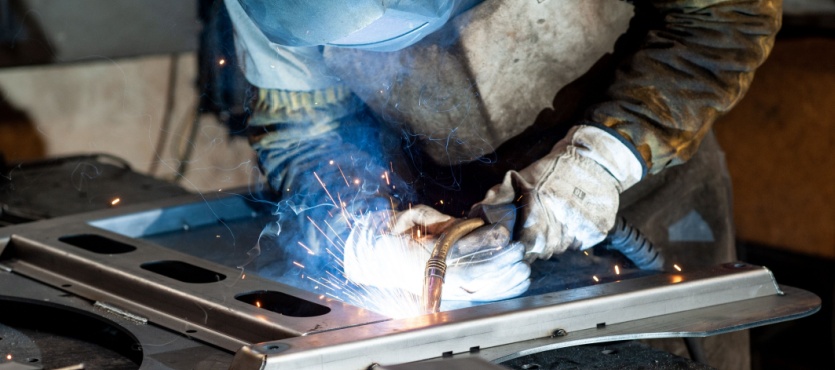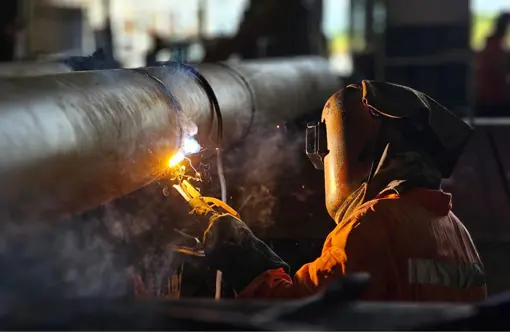Everything about Welding: Secret Insights Into Techniques and Best Practices for Success
Welding includes a selection of methods, each fit for certain products and applications. Recognizing these approaches, such as GMAW, SMAW, and TIG, is important for accomplishing ideal outcomes. The right tools and safety practices can not be forgotten. As preparation and fixing play essential functions in the welding process, understanding these aspects can considerably enhance the high quality of the last item. What are the crucial factors that assure an effective weld?
Recognizing Different Welding Methods
Welding techniques include a range of techniques, each suited to specific applications and products. Among one of the most typical methods are Gas Metal Arc Welding (GMAW), Protected Metal Arc Welding (SMAW), and Tungsten Inert Gas Welding (TIG) GMAW, also called MIG welding, is preferred for its rate and adaptability, making it ideal for slim materials. SMAW, or stick welding, is preferred for its simplicity and performance in outdoor settings, especially with thicker metals. TIG welding offers accuracy and control, making it suitable for intricate job and non-ferrous metals (Montana Mobile Welding and Repair Fabrication). Each method has its one-of-a-kind advantages and considerations, permitting welders to pick the most effective approach based on the project's needs, product type, and wanted end results. Comprehending these techniques is important for effective welding
Important Welding Devices and Tools
While numerous welding techniques call for specific skills, the ideal tools and tools are just as vital for attaining quality outcomes. Essential welding devices includes welding equipments, which differ depending on the technique-- such as MIG, TIG, or stick welding. Protective equipment, consisting of gloves, headgears, and aprons, warranties safety and security and convenience throughout the process. In addition, components and clamps aid secure materials in position, making certain accuracy in welds. Consumables like welding poles, cable, and protecting gas are additionally important components that affect the high quality of the weld. Furthermore, devices such as cutters and mills assist in surface preparation and post-weld ending up, adding to a specialist result. Investing in high-grade equipment ultimately improves the performance and efficiency of welding tasks.
Safety Practices in Welding
Appropriate safety and security methods are essential in the welding sector to protect employees from prospective dangers. Welders must wear ideal personal safety devices (PPE), including safety helmets with proper shading, handwear covers, and flame-resistant clothing. Ample ventilation is crucial to decrease direct exposure to hazardous fumes and gases produced during the welding procedure. Furthermore, workers must be learnt the proper handling of welding devices to protect against crashes. Fire safety and security measures, such as keeping flammable products away from the welding area and having fire extinguishers conveniently offered, are needed. Normal examinations of tools and work areas can assist recognize prospective dangers prior to they cause accidents. By sticking to these security methods, welders can create a more secure working setting and minimize dangers related to their profession.
Preparing Materials for Welding
Preparing materials for welding is an essential step that considerably affects the top quality and integrity of the final product (Montana Mobile Welding and Repair Welding). Correct prep work includes cleaning the surface areas to eliminate contaminants such as dirt, rust, and oil, which can compromise the weld. Methods such as grinding, sanding, or making use of solvents are generally employed to attain a tidy surface. In addition, making sure that the materials mesh snugly is important; gaps can lead to weak welds. It's likewise crucial to take into account the alignment and positioning of the parts, as this will impact the simplicity of welding and the last end result. Lastly, selecting the ideal filler material and making sure compatibility with the base steels is important for attaining solid, durable welds
Tips for Achieving High-Quality Welds
Attaining top quality welds needs attention to detail and adherence to best methods throughout the welding procedure. Proper joint prep work is necessary, making sure surfaces are totally free and tidy from pollutants. Choosing the ideal filler product and welding technique based on the base steels is vital for ideal bonding. Maintaining constant traveling rate and angle while welding can prevent problems and promote uniformity. Additionally, managing heat input is vital; extreme warm can lead to warping and damaged joints. If necessary, routinely inspecting the welds throughout the procedure allows for prompt adjustments. Finally, using appropriate post-weld treatments, such as cleaning and stress relief, can improve the resilience and integrity of the weld, ultimately making certain an effective outcome.
Repairing Common Welding Issues
Welding often provides challenges that can affect the top quality and stability of the final product. read this article Usual problems such as porosity, inconsistent weld beads, and overheating can occur, each needing particular troubleshooting methods. Recognizing these troubles is crucial for welders to improve their skills and accomplish ideal outcomes.
Porosity Problems Clarified
Porosity can often be neglected, it stays a crucial concern in welding that can endanger the integrity of a completed item. Porosity refers to the existence of little gas pockets within the weld bead, which can lead and damage the joint to premature failure. This problem typically emerges from pollutants, wetness, or inappropriate securing gas protection throughout the welding process. To mitigate porosity, welders should validate that the base materials are clean and dry, make use of proper protecting gases, and maintain constant welding parameters. On a regular basis inspecting the equipment and atmosphere can additionally assist determine potential concerns before they show up in the weld. Attending to porosity successfully is vital for attaining strong, resilient welds that fulfill high quality requirements.

Irregular Weld Beans
Irregular weld beads can considerably affect the top quality and stamina of a finished item. Numerous variables add to this problem, including incorrect travel rate, incorrect amperage setups, and irregular electrode angles. When the welder amp mig welder moves too rapidly, a grain might appear slim and lack infiltration, while relocating also gradually can trigger too much buildup. Furthermore, making use of the wrong amperage can result in either undercutting or extreme spatter, both of which compromise weld stability. The welder's method, such as irregular torch motion, can additionally result in irregular bead appearance. To alleviate these issues, welders must concentrate on maintaining stable, regulated movements and making certain appropriate equipment settings to accomplish harmony in their welds. Consistency is essential to achieving reputable and strong welds.
Overheating and Warping Issues
Extreme warmth throughout the welding process can cause considerable overheating and warping issues, influencing the architectural integrity of the workpiece. These issues usually materialize as distortion, which can jeopardize placement and fit-up, making additional assembly testing. Variables adding to overheating include the option of welding specifications, such as voltage and travel speed, in addition to the kind of material being welded. To mitigate these issues, welders must keep constant traveling speed and ideal warmth input while keeping an eye on the work surface temperature level. Additionally, preheating or post-weld warmth treatment can aid ease stresses triggered by rapid cooling - Welding. Routine evaluation and adherence to ideal practices are essential in avoiding overheating and ensuring the long life and dependability of bonded structures
Regularly Asked Concerns
What Are the Profession Opportunities in the Welding Industry?
The welding market provides diverse occupation possibilities, consisting of placements as welders, designers, examiners, and instructors. Professionals can operate in manufacturing, construction, aerospace, and vehicle sectors, benefiting from strong demand and affordable salaries in various functions.
Just How Can I Enhance My Welding Speed Without Sacrificing Quality?
To improve welding rate without compromising high quality, one ought to practice efficient strategies, preserve equipment, enhance settings, and boost hand-eye coordination. Normal training and seeking responses can likewise substantially add to accomplishing quicker, top notch welds.
What Certifications Are Readily Available for Welders?
Many accreditations exist for welders, including those read this post here from the American Welding Culture (AWS), the National Center for Construction Education And Learning and Research Study (NCCER), and different industry-specific companies. These credentials improve employability and show ability effectiveness.
Just How Does Welding Impact the Residences of Metals?
Welding influences the residential properties of metals by changing their microstructure, which can result in adjustments in ductility, strength, and solidity. Warmth input and air conditioning rates during the procedure considerably influence these material attributes.
Can I Bonded Dissimilar Metals With Each Other?
